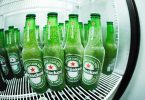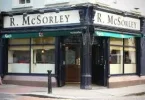Cocooning continues apace
In the UK, 35 per cent of consumers now think drinking at home is less hassle than going to a bar – 30 per cent admit to not liking crowded bars – while 27 per cent believe it’s more intimate at home. These are among the worrying findings contained in Mintel’s recent British Lifestyles 2011 report.
The past decade has held mixed fortunes for alcoholic drinks. The first half saw strong growth but since 2008 sales have suffered.
Mintel predicts that the UK alcohol market will contract in real terms by six per cent over the next five years as a result of taxation, health concerns and consumer spending constraints. Taxation, for example, will lead to above-inflation price rises (via the UK Government’s two-percentage-points-above-inflation ‘tax escalator’) at a time when consumer discretionary spend is already under pressure.
“Healthier attitudes also continue to drive behaviour changes in drinking and the UK is showing signs of belatedly moving towards a more continental drinking culture where there is more emphasis on quality than quantity,” states the report.
Continual price increases have seen some consumers priced out of the market altogether while others continue to drift towards in-home drinking.
And the report reckons that “price pressure” is unlikely to ease off any time soon as more and more people choose not to go out to the pub, bar or restaurant.
Confidence is at a low ebb, “Inflation remains above the Bank of England target range and earnings growth is very low”.
Despite the gloomy statistics Mintel reports that one in three adults likes having a local pub – “even if they’re not going to them” – considering them an important part of the social fabric.
“Even though the recession has technically ended, the recovery is extremely fragile with consumer spending down six per cent in Q1 2011,” states Mintel, “Inflationary pressures are putting a squeeze on consumer incomes, with prices of petrol, food and utilities rising, while wages are struggling to keep up with the resulting increase in the cost of living. This has created a new mood of prudence among consumers.”
With an over-reliance on the pub sector (itself in decline) then, beer and wine in particular will witness a decline in sales over the next five years, forecasts Mintel.
A lack of innovation in the sector is blamed for the dramatic decline in sales of lager in particular. This market declined in value in the years between 2006 and 2010 although the report predicts that this is due to recover over the next five years, estimating growth at 6.1 per cent between now and 2016.
Wine will also suffer because of its reliance on imports but Mintel observes, “Younger people (18-24 year-olds) may drink less wine than any other age group but they spend more per bottle when buying for in-home consumption (£8.35 versus £6.01 average). This is as a result of their lack of wine knowledge, meaning price becomes a barometer of quality and the fact that they are more likely to drink at home for special occasions”.
Bearing in mind it’s decline to date, MIntel has good news for the RTD sector.
“RTD (Ready-To-Drink) and alcoholic mixables (otherwise known as ‘alcopops’) have seen a dramatic decline as they fall victim to negative publicity around their perceived associations with underage drinking. The sector saw a decline of almost 50 per cent between 2006 and 2010 in constant terms (39 per cent in current values).
“RTD and alcoholic mixables are set to enjoy the greatest growth to 2016, making this the only sector to expect gains in both current and constant terms. This marks something of a sea change for the sector compared to its performance in 2006-10 and is largely attributable to the popularity of a new breed of ready-to-serve cocktails and spirits with mixers in a can. This new format has breathed new life into the category and helped to move it away from the negative image associated with alcopops.”
Generally speaking, Mintel points out, “Expenditure on most product categories was reduced or halted, with in-home food cannibalising eating out and a general trend towards ‘cocooning’ and bringing entertainment and leisure closer to home.
“In the five years up to 2010, spending on discretionary items (alcoholic drinks, home and garden purchases) and big-ticket items (cars, personal finance) were cautiously cut, while expenditure on necessities (food, rents, household utilities) has remained stable or increased.
“Spending on housing and personal and healthcare products remained unaffected, however, rising fuel prices have driven increases in the cost of transport. As people are forced to absorb the additional costs of necessities, they try to find areas where they can cut corners, with the primary victims being expenditure on leisure, eating out, clothing and home and garden.”
Indeed, consumers will continue to eat out but one third of them have already either reduced expenditure or the number of visits per month.
Pub catering
While the UK pub catering market has grown 46 per cent in value to £6.1 billion since 2000, growth has been “muted” of late. Nevertheless, pub catering represents an increasing proportion of sales. And whenever consumers do decide to eat, the report observes, “Diners are prioritising value, not lowest cost, with only 13 per cent of diners usually choosing the cheapest meal”.
‘Refuelling options’ are also being sacrificed at the expense of maintaining dining occasions which offer consumers more of an ‘experience’: eg operators in the lunch market have to focus on demonstrating where they are ‘adding value’: over a third of UK consumers have cut back on spending on lunch out of home in the last year and nearly four in 10 think that shop-bought sandwiches are overpriced.
Diners are trading down on products that they don’t feel have added value (eg bottled water) but not those that they do (eg wine): out of those who have reduced their spending on eating out, only 12 per cent say they only ever buy house wine compared to 22 per cent who order tap water not bottled water.
British Lifestyles 2011 also looks at what people buy when they’re feeling low.
A lack of money, combined with the rising cost of living in lower-income households means that they might browse but not buy, with something for the home, gadgets or clothing being top of their wish lists.
?“Image boosters, such as make-up and clothes, cheer up women whilst gadgets and alcohol are trusted friends for men”.
So the news is not all black then.
 Continual price increases have seen some consumers priced out of the market altogether while others continue to drift towards in-home drinking.
Continual price increases have seen some consumers priced out of the market altogether while others continue to drift towards in-home drinking.








